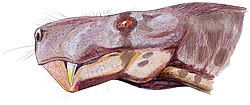Gorgonopsid
The Gorgonopsids [1] were Therapsids, a group of tetrapods which eventually gave rise to the cynodonts, with the cynodonts ultimately giving rise to mammals. Gorgonopsids probably had rhino like skin and still laid eggs.
| Gorgonopsia Temporal range: Middle to Late Permian
| |
|---|---|

| |
| Gorgonops | |
| Scientific classification | |
| Kingdom: | |
| Phylum: | |
| Class: | |
| Order: | |
| Suborder: | †Gorgonopsia Seeley, 1895
|
| Family: | †Gorgonopsidae Lydekker, 1890
|
| Subfamilies | |
|
Gorgonopsinae | |
Gorgonopsids were a successful group which lived during the Permian period, about 260 million years ago. They were members of the Class Synapsida and possibly related to the pelycosaurs. They became extinct in the Permian–Triassic extinction event.
They were the major predators of their day, having large, powerful, square-shaped jaws with huge, sabre-like canines and interlaced, socket-like teeth. Many fossils have been found in South Africa.
The most famous of all, Inostrancevia, was the size of Smilodon with a 45-cm long skull, and 12-cm long sabre-like teeth. The teeth were not as long as saber toothed cats but had a more robust skull. This predator could easily take down a Scutosaurus, or small animals such as Dvinosaurus.
The Gorgonopsidae are divided into three sub-families:
- Rubidginae, which had large, broad skulls,
- Gorgonopsinae, which included most of the gorgonopsid genera.
- Inostranceviinae
Gorgonopsid Media
Size comparison between a person and Inostrancevia (reconstructed with long lips and some hair)
Skull of Aelurosaurus felinus showing tooth arrangement, dual canines, and canine root depth
Reconstruction of Gorgonops
Head restoration of Eriphostoma, one of the oldest gorgonopsians
Head restoration of Arctognathus
Artist's impression of the head of Dinogorgon, a rubidgeine known from fossils from South Africa and Tanzania
DA21/17-01-01, a gorgonopsian specimen from the Permian Port des Canonge Formation of Mallorca, currently the oldest record of the group
Tetrapod distribution and temperature belts through the Upper Permian and Early Triassic








